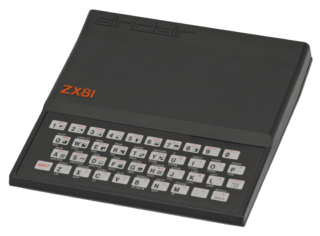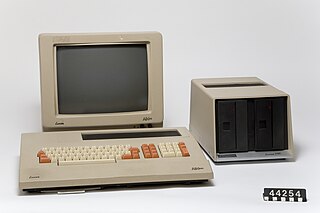
The IBM Personal Computer is the first microcomputer released in the IBM PC model line and the basis for the IBM PC compatible de facto standard. Released on August 12, 1981, it was created by a team of engineers and designers directed by William C. Lowe and Philip Don Estridge in Boca Raton, Florida.

The Jupiter Ace by Jupiter Cantab was a British home computer released in 1982. The Ace differed from other microcomputers of the time in that its programming environment used Forth instead of the more popular BASIC. This difference, along with limited available software and poor character based graphic display, limited sales and the machine was not a success.
The Sinclair QL is a personal computer launched by Sinclair Research in 1984, as an upper-end counterpart to the ZX Spectrum.

The TRS-80 Micro Computer System is a desktop microcomputer launched in 1977 and sold by Tandy Corporation through their Radio Shack stores. The name is an abbreviation of Tandy Radio Shack, Z80 [microprocessor]. It is one of the earliest mass-produced and mass-marketed retail home computers.

The Sinclair ZX80 is a home computer launched on 29 January 1980 by Science of Cambridge Ltd.. It is notable for being one of the first computers available in the United Kingdom for less than a hundred pounds. It was available in kit form for £79.95, where purchasers had to assemble and solder it together, and as a ready-built version at £99.95.

The ZX81 is a home computer that was produced by Sinclair Research and manufactured in Dundee, Scotland, by Timex Corporation. It was launched in the United Kingdom in March 1981 as the successor to Sinclair's ZX80 and designed to be a low-cost introduction to home computing for the general public. It was hugely successful; more than 1.5 million units were sold. In the United States it was initially sold as the ZX-81 under licence by Timex. Timex later produced its own versions of the ZX81: the Timex Sinclair 1000 and Timex Sinclair 1500. Unauthorized ZX81 clones were produced in several countries.
BBC BASIC is an interpreted version of the BASIC programming language. It was developed by Acorn Computers Ltd when they were selected by the BBC to supply the computer for their BBC Literacy Project in 1981.
Kaypro Corporation was an American home and personal computer manufacturer based in Solana Beach in the 1980s. The company was founded by Non-Linear Systems (NLS) to compete with the popular Osborne 1 portable microcomputer. Kaypro produced a line of rugged, "luggable" CP/M-based computers sold with an extensive software bundle which supplanted its competitors and quickly became one of the top-selling personal computer lines of the early 1980s.

The Luxor ABC 800 series are office versions of the ABC 80 home computer. They featured an enhanced BASIC interpreter, a slightly faster clocked CPU and more memory: 32 kilobytes RAM and 32 KB ROM was now standard, the Z80 is clocked at 3 MHz. It featured 40×24 text mode with eight colors or 80×24 text mode monochrome. They could also be extended with "high" resolution graphics using 16 KB RAM as video memory.

The IBM 5100 Portable Computer is one of the first portable computers, introduced in September 1975, six years before the IBM Personal Computer, and eight before the first successful IBM compatible portable computer, the Compaq Portable. It was the evolution of a prototype called the SCAMP that was developed at the IBM Palo Alto Scientific Center in 1973. Whether considered evolutionary from SCAMP or revolutionary, it still needed to be plugged into an electric socket.

Apple II clones are computers that share functionality with the Apple II series but were not created by Apple. The Apple II home computer series was frequently cloned, both in the United States and abroad, in a similar way to the IBM PC. According to some sources, more than 190 different models of Apple II clones were manufactured. Most could not be legally imported into the United States. Apple sued and sought criminal charges against clone makers in more than a dozen countries.

Dataindustrier AB or DIAB was a Swedish computer engineering and manufacturing firm, founded in 1970 by Lars Karlsson and active in the 1970s through 1990s. The company's first product was a board-based computer centered on a specific bus named Data Board 4680. This unit was used for automatic control in several Swedish industries as would be almost all of DIAB's computers. DIAB is mostly known for engineering the ABC 80, the first Swedish home computer, manufactured by Luxor AB.

The PC-8000 series is a line of personal computers developed for the Japanese market by NEC. The PC-8001 model was also sold in the United States and Canada as the PC-8001A.

The history of the personal computer as a mass-market consumer electronic device began with the microcomputer revolution of the 1970s. A personal computer is one intended for interactive individual use, as opposed to a mainframe computer where the end user's requests are filtered through operating staff, or a time-sharing system in which one large processor is shared by many individuals. After the development of the microprocessor, individual personal computers were low enough in cost that they eventually became affordable consumer goods. Early personal computers – generally called microcomputers – were sold often in electronic kit form and in limited numbers, and were of interest mostly to hobbyists and technicians.

Mera–Elzab Meritum – a family of Polish personal computers based on TRS-80 Model I with BASIC Level II. Manufactured in the 1980s by Mera–Elzab in cooperation with ITM company.

The British Broadcasting Corporation Microcomputer System, or BBC Micro, is a series of microcomputer designed and built by Acorn Computers Limited in the 1980s for the Computer Literacy Project of the BBC. Designed with an emphasis on education, it was notable for its ruggedness, expandability, and the quality of its operating system. The machine was the focus of a number of educational BBC TV programmes on computer literacy, starting with The Computer Programme in 1982, followed by Making the Most of the Micro, Computers in Control in 1983, and finally Micro Live in 1985.

Home computers were a class of microcomputers that entered the market in 1977 and became common during the 1980s. They were marketed to consumers as affordable and accessible computers that, for the first time, were intended for the use of a single, non-technical user. These computers were a distinct market segment that typically cost much less than business, scientific, or engineering-oriented computers of the time, such as those running CP/M or the IBM PC, and were generally less powerful in terms of memory and expandability. However, a home computer often had better graphics and sound than contemporary business computers. Their most common uses were word processing, playing video games, and programming.














